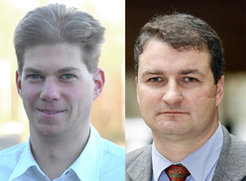European Research Council Consolidator Grants Appointed to Peter Baum and Reinhard Kienberger
What happens deep inside the ultimate electronics of our future? This is the question to be studied by Dr. Baum and his team, as they attempt to film the movements within electronics through space and time.
It is subsidies from the European Research Council (ERC), which enable young researchers to push their career forward, thanks to a generous grant and funding period of five years. Requirements for acceptance include an excellent research proposal as well as promising scientific development.

Peter Baum has acted as group leader of the Ultrafast Electron Imaging Research Group in the Laboratory for Attosecond Physics of Prof. Ferenc Krausz (Chair for Experimental Physics at the Ludwig-Maximilians-Universität Munich and Director at the Max Planck Institute of Quantum Optics in Garching, Germany since 2008. Having received funding from the ERC, he now plans to measure and visualize ultrafast electron movements in and around atoms. To achieve this, an approach of using stroboscopic diffraction and microscopy with ultrashort particle pulses consisting of very dilute, single-electron wave packets (which are controlled in space and time by sculpted light waves) is used. This should, at the very least, provide a direct visualization of all relevant electronic activity in space and time, revealing the fundamental physics which allow or limit the high-speed electronics of the future.

Reinhard Kienberger is professor at the Technische Universität München (TUM) and a Max Planck Fellow at the Max Planck Institute of Quantum Optics and intending to use the Grant for multiple, different projects, the first of which involves placing electronic processes in high temperature super conductors (an important step towards using the loss-free conductors for technical applications). Other projects include fundamental research in sun-based production of regenerative fuel (e.g. example hydrogen), and investigating charge transfer in biomolecules, in order to learn more about transport of information and energy in living organisms or bodily malfunctions/diseases. Over the next five years, and by utilizing a new system of high performance laser, the experiments will be undertaken at the TUM. Karolina Schneider

